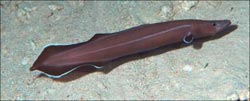Scientists discover the most primitive living eel

Scientists at the Smithsonian and partnering organizations have discovered a remarkably primitive eel in a fringing reef off the coast of the Republic of Palau. This fish exhibits many primitive anatomical features unknown in the other 19 families and more than 800 species of living eels, resulting in its classification as a new species belonging to a new genus and family. Credit: Jiro Sakaue<br>
Scientists at the Smithsonian and partnering organizations have discovered a remarkably primitive eel in a fringing reef off the coast of the Republic of Palau. This fish exhibits many primitive anatomical features unknown in the other 19 families and more than 800 species of living eels, resulting in its classification as a new species belonging to a new genus and family. The team's research is published online in the Proceedings of the Royal Society B, Aug. 17.
Many of the physical features of this new genus and species of eel, Protoanguilla palau, reflect its relationship to the 19 families of Anguiliformes (true eels) currently living. Other, more primitive physical traits, such as a second upper jaw bone (premaxilla) and fewer than 90 vertebrae, have only been found in fossil forms from the Cretaceous period (140 million to 65 million years ago). Still other traits, such as a full set of bony toothed “rakers,” in the gill arches are a common feature in most bony fishes, but lacking in both fossil and living eels. The team's analyses of total mitochondrial DNA indicate that P. palau represents an ancient, independent lineage with an evolutionary history comparable to that of the entire order of living and fossil eel species.
“The equivalent of this primitive eel, in fishes, has perhaps not been seen since the discovery of the coelacanth in the late 1930s,” said Dave Johnson, ichthyologist at the Smithsonian's National Museum of Natural History and lead author of the team's research. “We believe that such a long, independent evolutionary history, dating back to the early Mesozoic (about 200 million years ago), retention of several primitive anatomical features and apparently restricted distribution, warrant its recognition as a living fossil.”
Anguilliformes, a distinct group of bony fishes, first appeared in the fossil record about 100 million years ago. They eventually lost their pelvic fins, and their dorsal, anal and caudal fins became continuous. Living eels are very diverse and can be found in a large variety of habitats—from shallow coastal waters to the deep open ocean.
“The discovery of this extraordinary and beautiful new species of eel underscores how much more there is to learn about our planet,” Johnson said. “Furthermore, it brings home the critical importance of future conservation efforts—currently this species is known from only 10 specimens collected from a single cave in Palau.”
Media Contact
More Information:
http://www.si.eduAll latest news from the category: Life Sciences and Chemistry
Articles and reports from the Life Sciences and chemistry area deal with applied and basic research into modern biology, chemistry and human medicine.
Valuable information can be found on a range of life sciences fields including bacteriology, biochemistry, bionics, bioinformatics, biophysics, biotechnology, genetics, geobotany, human biology, marine biology, microbiology, molecular biology, cellular biology, zoology, bioinorganic chemistry, microchemistry and environmental chemistry.
Newest articles

Silicon Carbide Innovation Alliance to drive industrial-scale semiconductor work
Known for its ability to withstand extreme environments and high voltages, silicon carbide (SiC) is a semiconducting material made up of silicon and carbon atoms arranged into crystals that is…

New SPECT/CT technique shows impressive biomarker identification
…offers increased access for prostate cancer patients. A novel SPECT/CT acquisition method can accurately detect radiopharmaceutical biodistribution in a convenient manner for prostate cancer patients, opening the door for more…

How 3D printers can give robots a soft touch
Soft skin coverings and touch sensors have emerged as a promising feature for robots that are both safer and more intuitive for human interaction, but they are expensive and difficult…





















